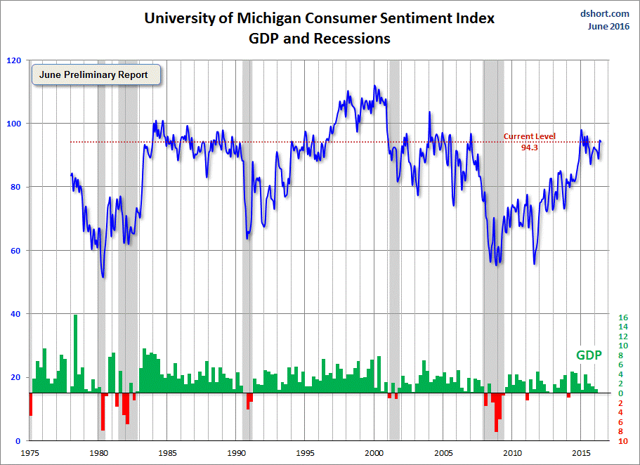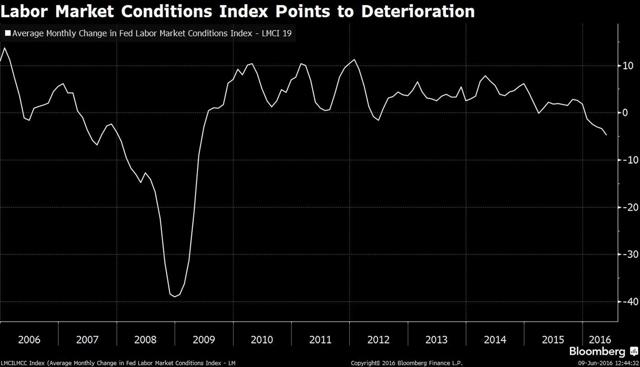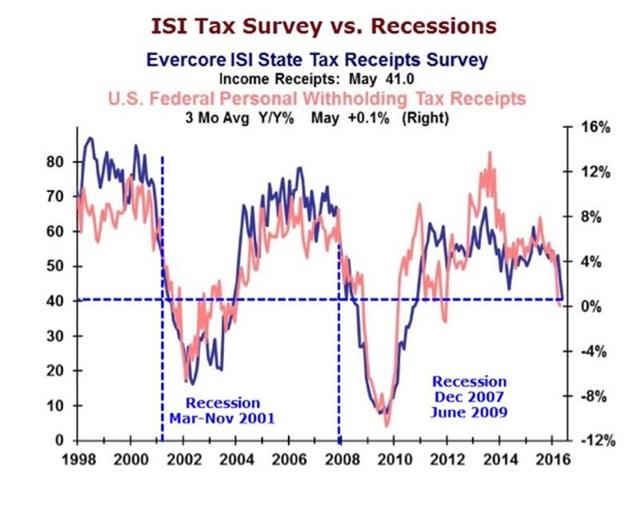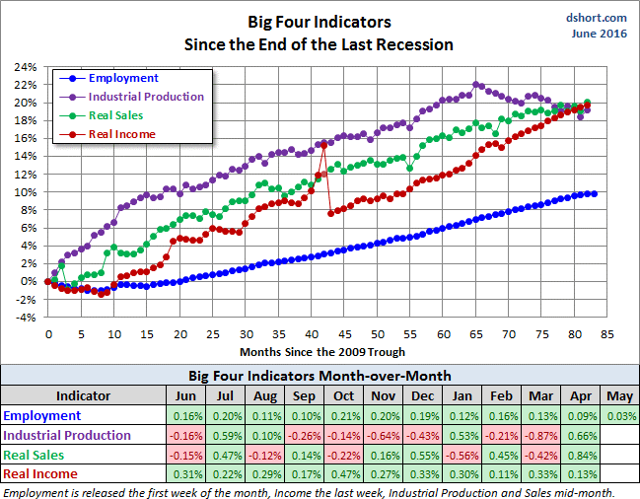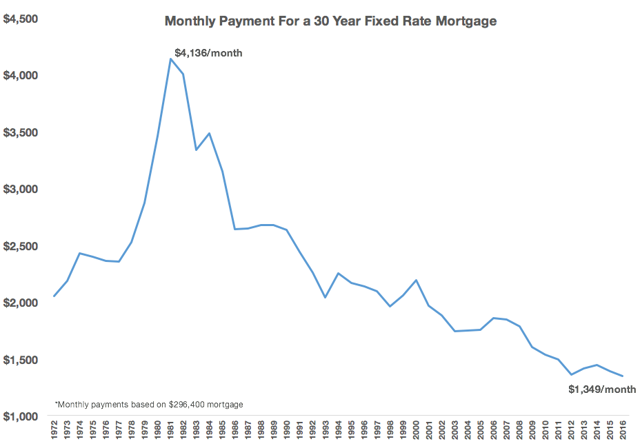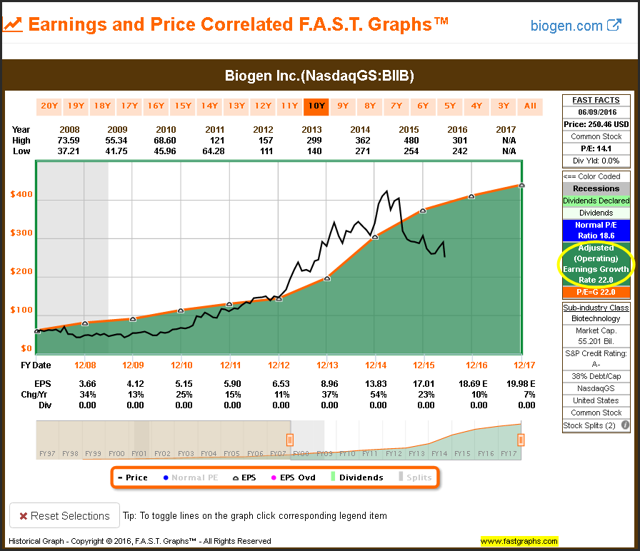This week's economic calendar is back to normal, with Wednesday's FOMC announcement the highlight. Last Friday's trading put the Brexit effects on the front burner, so I expect two themes for the week ahead. The first few days will be all about the Fed and any hints about the pace of rate increases. After the Fed meeting the emphasis will shift to the Brexit build-up, culminating next week.
Expect some punditry magic. The regular Fed experts will morph into Brexit gurus by Thursday morning!
Last WeekThere was little economic news. What we had was encouraging. Once again, markets were pretty firm-until Friday!
Theme RecapIn my last WTWA, I predicted plenty of attention to the weak employment report and the implications for stocks. That was a pretty good guess for the early part of the week. There were some who joined me in noting the problems with this report and also plenty who created those "rolling over" curves that are so popular. Every day there was another story from a big-name trader or manager expressing concern about the weak global economy. (More on that topic in the Investor section below).
The Story in One ChartI always start my personal review of the week by looking at this great chart from Doug Short. You can clearly see the quiet market, at least until Friday! Doug has a special knack for pulling together all of the relevant information. His charts save more than a thousand words! Read his entire post where he adds analysis and several other charts providing long-term perspective.
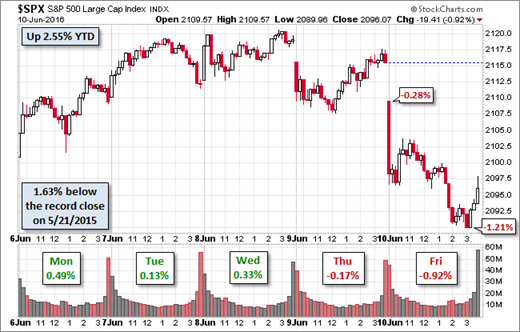
Each week I break down events into good and bad. Often there is an "ugly" and on rare occasion something really good. My working definition of "good" has two components. The news must be market friendly and better than expectations. I avoid using my personal preferences in evaluating news - and you should, too!
The Good
- Framing lumber prices are higher. Calculated Risk has data, charts, and analysis on indicators you will note see elsewhere.
- The employment story is upbeat. Despite last week's monthly employment report, many indicators are encouraging.
- Corporate layoffs are lower. Challenger, Grey, and Christmas (via Scott Grannis).
- Workforce vitality (via ADP) continues to climb.
- Initial jobless claims fell to 264K. Since these data are both timelier and less subject to revision (although reflecting only losses, not gains) more are wondering whether last month's employment report was a one-off.
- The House passed the Puerto Rico Rescue Legislation. (The Hill) This is less about the merits of the specific bill than the bipartisan effort. Some cooperation will be needed next year!
- Hotel occupancy is close to the record pace. (Calculated Risk).
- U.S households richer than ever whether measured in nominal, real, or per capita terms. (Scott Grannis)
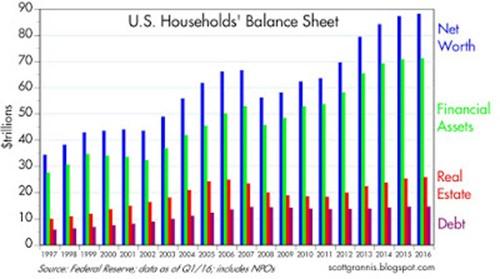
- Consumer sentiment from the Michigan survey remains solid. The Doug Short chart (via associate Jill Mislinski) has a great combination of history, the GDP relationship, and past recessions.
The Bad
- The rail contraction is getting worse. Steven Hansen (GEI) has the update.
- Brexit odds increased. A poll showed a big shift, with a ten percent lead for the "Leave" faction. The immediate reaction was this (questionable) chain: lower pound à lower Euro à stronger dollar à lower commodity prices à implication of slower growth à RISK OFF!!
- Downbeat economy makes June action by the Fed unlikely. Our go-to Fed expert, Tim Duy, looks at the data in the wake of the employment report. He also provides a Fed preview, highlighting labor conditions.
The Ugly
The candidate reaction. I have seen many elections where people were unhappy with the choices, but nothing quite like this. 10% of homebuyers say they will consider moving if their candidate loses. It is probably an exaggeration, but still an interesting reflection on the times.The Silver Bullet
I occasionally give the Silver Bullet award to someone who takes up an unpopular or thankless cause, doing the real work to demonstrate the facts. This week's award goes to New Deal Democrat at the Bonddad Blog. Not only did he take on an extremely popular and deceptive chart, he put the research together and reacted in a timely fashion. Here is the bogus chart:
The chart quickly spread as the "Doomer graph du jour." I saw it on several sites. There is widespread lust for "evidence" of a new recession. Charts like this are frustrating - so many misleading stories, so little time.
The Silver Bullet winners should get appropriate and timely recognition.
As is often the case with these bad charts, the original author does not provide either data or sources! Everyone who wants attention and confirmation bias republishes the chart. NDD demonstrates that the timing of the recession calls is completely wrong if one accounts for the actual availability of the data. This is a common amateur blunder.
I encourage you to read the painstaking efforts to reconstruct and explain the data at Bonddad and also Matt Trivisonno's blog.
The Week Ahead
We would all like to know the direction of the market in advance. Good luck with that! Second best is planning what to look for and how to react. That is the purpose of considering possible themes for the week ahead. You can make your own predictions in the comments.
The Calendar
We have a fairly big week for economic data and news. I highlight only the most important items, helping us all to focus.
The "A" List
- FOMC rate decision (W). The Yellen press conference will get close attention.
- Housing starts and building permits (F) Will the rebound continue?
- Retail sales (T). Of special interest in the wake of weak earnings from some retailers.
- Industrial production. A highly volatile series, but important.
- Initial claims (Th). The best concurrent indicator for employment trends.
The "B" List
- CPI (Th). Inflation is not getting much attention. It will take a few hot reports before this regains significance.
- PPI. See CPI above.
- Business inventories. April data, but relevant for Q2 GDP.
- Philly Fed (Th). One of the two regional surveys that has some market impact.
- Crude inventories. Often has a significant impact on oil markets, a focal point for traders of everything.
Beyond the FOMC meeting itself, there is no FedSpeak.
Next Week's Theme
It is a rather normal week for economic data, with the FOMC announcement on Wednesday at the highlight. I expect the Fed to be the focus for the first part of the week, with attention shifting to Brexit on Thursday. Next week will feature an even larger Brexit focus. We therefore have a twin theme:
Will the Fed signal any change in the pace of rate increases?
Will the Brexit odds change, and what are the implications?
There is little to add on the Fed issue, which is probably the most over-analyzed in history.
Concerning Brexit, we have three questions (at least):
- What are the odds of the June 23rd vote? The most recent poll shows a 10% bulge for Leave, but the bookies do not really endorse this.
- What are the issues? It is helpful to understand both the facts and what people believe to be at stake - things like immigration, membership costs, trade relationships, impact on health care, and availability of employment. Does any of this have a familiar sound? Putting aside whatever opinion you might have, what are the implications?
- What are the Brexit consequences? For Britain, for Europe, and for the rest of the world?
Quant Corner
We follow some regular great sources and also the best insights from each week.
Risk Analysis
Whether you are a trader or an investor, you need to understand risk. Risk first, rewards second. I monitor many quantitative reports and highlight the best methods in this weekly update.
The Indicator Snapshot
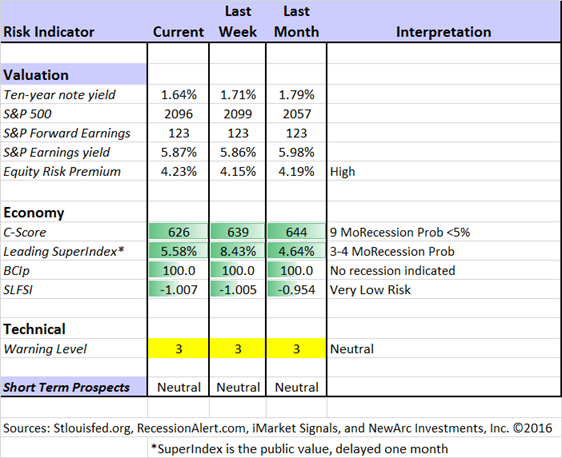
The Featured Sources:
Brian Gilmartin: Analysis of expected earnings for the overall market as well as coverage of many individual companies. This week he expresses more confidence about growth in earnings.
Bob Dieli: The "C Score" which is a weekly estimate of his Enhanced Aggregate Spread (the most accurate real-time recession forecasting method over the last few decades). Monthly reports including both an economic overview of the economy and employment.
RecessionAlert: Many strong quantitative indicators for both economic and market analysis. While we feature the recession analysis, Dwaine also has a number of interesting approaches to asset allocation.
Georg Vrba: The Business Cycle Indicator, and much more. Check out his sitefor an array of interesting methods. His latest update features his unemployment rate recession indicator. A recession is unlikely "any time soon."
Holmes: Our cautious and clever watchdog, who sniffs out opportunity like a great detective, but emphasizes guarding assets.
Doug Short: The Big Four Update, the World Markets Weekend Update (and much more).
The ECRI has been dropped from our weekly update. It was not so much because of the bad call in 2011, but the stubborn adherence to this position despite plenty of evidence to the contrary. You can still follow them via Doug Short and Jill Mislinski. Their commentary remains bearish despite the upturn in their own index. While no one really knows what is in the black box, I suggested years ago that they incorrectly emphasized too many commodity series, falling victim to multi-collinearity. Commodity prices fooled them in 2011. Now they seem to be ignoring the rebound.
How to Use WTWA
In this series I share my preparation for the coming week. I write each post as if I were speaking directly to one of my clients. For most readers, they can just "listen in." If you are unhappy with your current investment approach, we will be happy to talk with you. I start with a specific assessment of your personal situation. There is no rush. Each client is different, so I have six different programs ranging from very conservative bond ladders to very aggressive trading programs. A key question:
Are you preserving wealth, or like most of us, do you need to create more wealth?
My objective is to help all readers, so I provide a number of free resources. Just write to info at newarc dot com. We will send whatever you request. We never share your email address with others, and send only what you seek. (Like you, we hate spam!) Free reports include the following:
- Understanding Risk - what we all should know.
- Income investing - better yield than the standard dividend portfolio.
- Felix and Holmes - top artificial intelligence techniques in action.
- Why 2016 - The Year of the Value Stocks - finding cheap stocks based on long-term earnings.
You can also check out my website for Tips for Individual Investors, and a discussion of the biggest market fears. (Please send any questions or suggestions for new topics.)
Best Advice for the Week Ahead
The right move often depends on your time horizon. Are you a trader or an investor?
Insight for Traders
We consider both our models and also the best advice from sources we follow.
Felix and Holmes
We continue our neutral market forecast. Felix is fully invested, but the sector balance has become more conservative. Most sectors remain in the penalty box. The (usually) more cautious Holmes is almost fully invested. Holmes uses a universe of nearly 1000 stocks, selected mostly by liquidity. Even when the overall market is neutral, there will often be some strong candidates. That is what we see now. It is not a resounding endorsement of the overall market, but a vote for opportunistic trading.
Top Trading Advice
Anora Mahmudova (MarketWatch) exposes a deceptive chart pattern - the head-and-shoulders. I am interested in hearing from traders about this, but these complex charts seem open to misinterpretation. We rarely hear about failing setups.
Pradeep Bonde has some good advice for improving on a daily basis. He notes that it takes five years for traders to develop the needed skill.
Insight for Investors
Investors have a longer time horizon. The best moves frequently involve taking advantage of trading volatility!
Best of the Week
If I had to pick a single most important source for investors to read, it would be a split decision. There is plenty of dangerous and deceptive information about the alleged warnings of big fund managers. Some of these were incorrect, while others were just misleading. In one case the always-bearish prognosticator, Mr. Dow 5000, cannot decide if the Fed has engineered deflation or hyper-inflation. (A supernova can either implode or explodes, he explains). It is all going to blow up somehow, so you should own his bond fund instead. OK….
Here are some helpful articles. If you read them, you will have some inoculation against hype.
- Ichan is out of Apple while Buffett is in. Valuation guru Aswath Damodaranlooks at time frames, methods of analysis, and the perspective of traders versus investors. It is tough work for most readers, but if you want to make good decisions as an individual investor, you need to understand this.
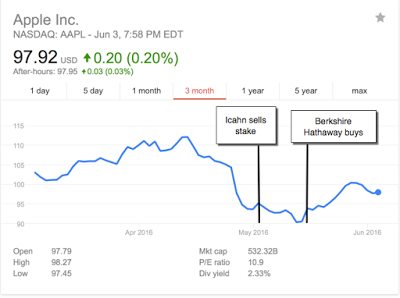
As well as the entire process -
- Soros reports related to his family office. We don't know why or when viewpoints might change. (Josh Brown)
- Soros has (supposedly) been wrong on many prior "turning point" occasions. (Cullen Roche)
- And last, but I hope not least, I have demonstrated that government filings are completely worthless. Because they do not report short positions, you only see a part of each trade. This is especially bad on option positions, where the media report long positions in puts (a short instrument) without description of the entire spread. The notion that being short a put is actually a long position in the underlying befuddles nearly everyone. Even the most prominent media sources provide absolutely no help on this subject. Instead the reporters are assigned a story about the Soros put holdings. My multiple articles on this have not gotten much attention, despite the careful research and examples.
Stock Ideas
We have some diverse suggestions this week.
Think outside the box with James Altucher. He brainstorms on how we can profit now from something we know is coming: the driverless car. This fits my definition of something you will not read about in tomorrow's paper.
I tried to provide another example (Finding the Best Contrarian Stocks), answering some reader questions from last week about why I preferred banks to utilities.
Sometimes you know the theme from current events, but you might not know the best stock play. I am not a big fan of anonymous authors, but sometimes follow them until I am convinced of the quality. Valuentum explains why Palo Alto Networks (NYSE:PANW) is more attractive than one might originally think. Hint: free cash flow. We reached the same conclusion a few weeks ago.
Sector Ideas
Energy prices have been less wild, which is probably good for investors. Some experts are even picking up my recent theme that $50 oil may be something of a barrier, with current prices representing a "sweet spot" for the economy. Oil Insider asks, Have Oil Prices Hit the Sweet Spot? (subscription required, but here is a key chart).
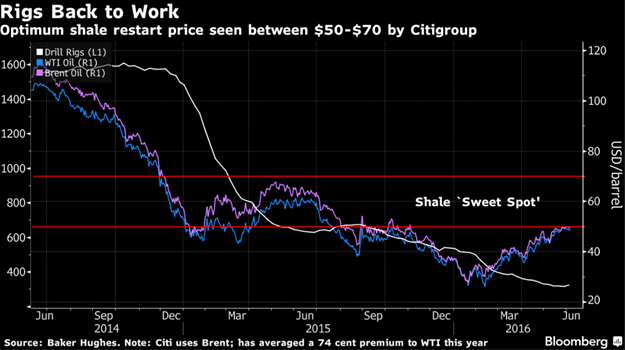
Anyone interested in energy eagerly awaits the annual Statistical Review of World Energy from BP. Here is a key summary chart:
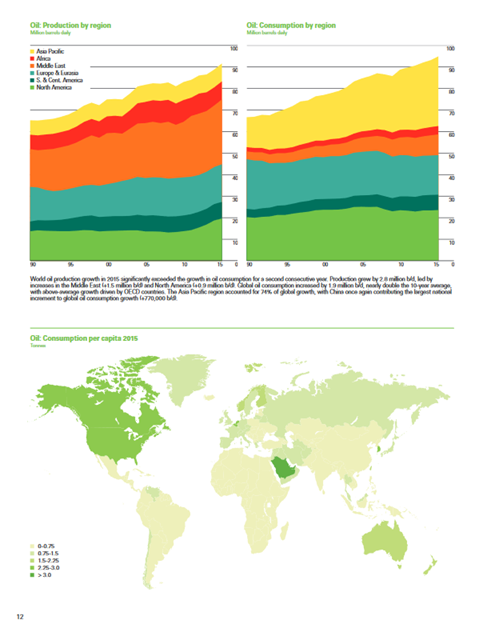
Housing has been one of my favorite themes this year, and it got plenty of attention this week.
- Housing is "eating the economy" says Conor Sen. Here is a key part of his case for further expansion:
One way to show how much more growth housing, and construction more generally, has in front of us is to look at construction's share of total employment. It's currently 4.6%, and in every cycle ever it's gotten to at least 5%. Given 1) the size and hence housing needs of the Millennial generation in years to come, 2) the lack of construction, of single family especially, since the financial crisis, 3) the potential for infrastructure spending from the next president, whether it's the Hillary/Dem version or the Trump "build a wall" version, 5% seems like a reasonable conservative target for how high this will go over the next 3-5 years.
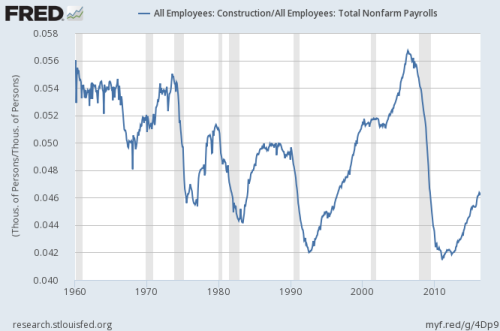
- Ben Carlson asks, Has There Even Been a Better Time to be a Homebuyer?After describing interesting data showing the difference between today's houses and those built in 1973, he summarizes:
Houses today also have wireless Internet connectivity, better appliances, and are generally more energy efficient. They aren't making enough of them in my estimation - and I may be stating the obvious here - but new homes today look better, have more features and are higher quality than those built in the past.
To summarize - houses today have fewer people living in them with more space, more bedrooms, more bathrooms and more comfortable living conditions.
But wait…there's more.
Mortgage rates are at record lows:
- Ivy Zelman, a leading housing expert noted for frank and accurate analysis, did an interview with Barron's. Here is a key quotation:
Barron's: April new home sales soared 17%. Where are we in the housing recovery?
Zelman: Four years in. The first increase was in 2012. There are multiple years ahead. We are still 35% below a normalized level of starts, and that's for a single-family. Every cycle is different. This cycle will be elongated, and the slope of the recovery is flatter than what we thought the trajectory would look like when we called the bottom in 2012. Builders have been slower to see the growth. There's a shortage of shelter. We're pretty indifferent whether shelter should be owned or rented. We're just saying there isn't enough. The U.S. is at a 30-year low of inventory available for sale. We are predicting double-digit housing-starts growth this year, next year, and in 2018.
The interview includes a number of stock ideas, including two which we own (LEN and CAA).
- Robert Shiller (via Mark Thoma) says that fears of being priced out of housing are "overinflated." In analyzing fears based upon quite different factors, Prof. Shiller wonders, "why do people still worry that home prices are getting out of reach? The answer can't be found in the housing data".
Biotech is worth a look.
- Charles Pennington notes the long-term success of biotech, using the Fidelity biotech fund as evidence. A better buy than in 1988?
- Chuck Carnevale has five candidates for consideration. As always, he carefully notes which stocks might be better for a given investment objective. And of course you get a master class in using the F.A.S.T Graphs method. Here is one chart for one example. You need to read the entire post to appreciate the depth of the analysis.
Personal Finance
Professional investors and traders have been making Abnormal Returns a daily stop for over ten years. The average investor should make time (even if not able to read AR every day as I do) for a weekly trip on Wednesday. Tadas always has first-rate links for investors in his weekly special edition. There are always several great choices worth reading, but my favorite this week is an article from Morningstar's Russ Kinnel, 20 Common Investing Mistakes. It is a nice analysis of how emotions interfere with decision making and the need for planning. Here are two of my favorites, both very common:
Mistake 2 | Basing sell decision on cost basis.
You bought fund A at $10 and now its net asset value is at $5. You bought fund B at $10 and now it's at $20. Which should you hold, and which should you sell? I have no idea. The amount you paid is relevant only to tax planning. What matters is which will have better returns over your investment horizon. If the answer is fund B, then sell fund A (you'll have a tax benefit if it's in a taxable account) and put the proceeds in fund B. The problem is that people have an emotional attachment to the price. Some are afraid to book losses, and others are too anxious to sell a winner for fear that they'll miss out on gains. What matters is whether the funds have strong fundamentals.
Mistake 17 | Misreading your own abilities.
People who treat gambling addicts say that it's the big winning bet that hooks gamblers. They get high and want to repeat that high. Fund investors can be a little like that. They remember that one time they accurately called the direction of the market or picked a sector fund, and they forget all the times their calls were off. Go back over your past investments. See what you do well, and figure out a solution for the areas where you didn't do well. Maybe your individual stock picks aren't that great overseas, so you should buy a foreign fund. Maybe your bond fund blew up, so you should change the way you pick bond funds and tone down the risk.
I try to include good advice for young investors, but there is a real shortage of material. MarketWatch has seven good tips for those in their 30's. Many boomers wish they had known these when they were younger!
Watch out for….
Hedge funds (and similar opportunities). Rachael Levy explains, The secret to investing in hedge funds.
Cambridge Associates is one of the biggest investment consultants advising pensions and others on which funds to choose.
Their secret to picking hedge funds: avoid almost all of them.
"We think about 5% of the entire universe could be on a list of potential funds to look at," Joe Marenda, a managing director at Cambridge, told Business Insider.
Final Thoughts
There could be a lot of volatility this week - important for traders, but pretty meaningless for investors. At least for those who keep their heads.
I expect nothing meaningful from the Fed meeting, but that will not stop the punditry. There will be massive efforts to infer something.
The Brexit story will include updated odds and I expect it to be the theme next week. I have no special insight about how this will turn out. I am watching my sources closely, especially concerning the possible economic impacts. I was accurate last week in noting this has something to watch, but no one really has a good handle on the implications.
Traders can try to guess the outcome and the reaction. Investors should approach the week ahead with a shopping list. Get ready to take advantage of opportunities. In this WTWA I tried to provide special emphasis on stock ideas. I hope it will provide some ideas for your own research.
Disclosure: I am/we are long LEN, CAA, AAPL.
I wrote this article myself, and it expresses my own opinions. I am not receiving compensation for it. I have no business relationship with any company whose stock is mentioned in this article.

















